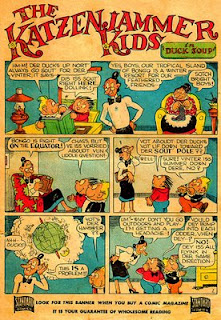
Comic strips are still very popular today. Between the popularity of mangas, the revival of superheroes (their influence has progressed toward T.V., with the T.V. show Heroes for example) and the spread of comic strips on the big screen (Persepolis, by Marjane Satrapi was a great success), comic strips have become a worldwide product. Comic strips in the USA became popular thanks to the press. During the beginning of the 20th century, comic strips were published in the last pages of newspapers. It started out with “Hogan's Alley” by Richard Outcault in 1895, “Katzenjammer Kids” by Rudolph Dirks in 1897 and “Little Nemo in Slumberland” by Winsor McCay in 1905. There has been a real revival of the comic strip genre in the 1990's and since then, comic strips have been declined on different mediums. Comic strip, much like all form of entertainment, can now be found on the internet : they are called webcomics. They suffer, just like the music and film industry, of illegal downloading. Nevertheless, the format of a comic strip is much different from the one of a cd or a film. It seems as though the pleasure taken from reading a comic strip is partly due to the medium itself, to the holding of a nice object. Do comic strips and the internet make a good match ?
Comic strips can now be found and read on the internet. Of course, there is the alternative of downloading them and reading the strips on a computer. This is put on the internet and can be analyzed as contributing to Pierre Levy's concept, collective intelligence. The concept of collective intelligence signifies that the group has more knowledge than the individual, if the information each individual has is put together. Putting comic strips on the internet and giving it free access is a way of sharing information and contributing to Internet’s "brain". Most of these comics published on a website can be found exclusively on the internet. The first webcomic was Witches and Stitches put on the internet in 1985. Internet gives the possibility to anyone to publish their own comic. The genre has become so popular that there are now many user-generated comics site. They are search engines that permit to find a comic strip, depending on the genre, the country and other categories and read them. There is a real work in making accurate metadata, and therefore contributing to a functioning collective intelligence. For example, there is www.drunkduck.com, "the Webcomics Community". Along with hosting for free webcomic creators, it also has a forum which permits interaction between the different fans. This enlarged community helps prevent what Cory Doctorow calls "metacrap". Indeed, the contribution of many on these comic strips portals ensures a certain quality, where the consumer chooses freely and judges honestly. DrunkDuck, in its description, adds :"We offer many free tools and a strong community to not only help a webcomic creator publish their work online, but also to continually learn and grow as an artist. As the quality of the work improves, so will the quantity of the audience.". The user of the internet can become a productor in two ways : by creating a webcomics or by commenting and participating in the comics fan community online and suggesting new ideas to the artist. Webcomics are a clear manifestation of “produsage”. Axel Burns defined this term as a system where consumers are producers as well. This can be possible only in web 2.0. A top-down system between the editors and the readers does not exist anymore with webcomics : the internet gives more freedom to the author, who does not have to please and make concessions for the comics editors, who does not have to impose himself any limits on the choice of themes, subjects and vocabulary. The author is given total artistic freedom. This is very true to the extent that we can find the inversed scheme : confirmed comic strips artists find refuge on the Internet to deliver to its readers more explicit content. On the French website www.bdcul.com (closed down last year), artists can expose their pornographic comic strips without restriction. The author’s only limit is the goal of getting positive reception from the Internet fan community.
Nevertheless, even if comic strips can pull many advantages out of the internet, the ultimate goal remains : to publish the story in a hard format. The medium of the Internet seems to be more a first step toward popularity and artistic reconnaissance. Indeed, webcomics artists are not financially self-sustainable. Furthermore, the importance of the paper object still exists. The internet has only copied the format of comic strips on a screen : The medium of the internet does not bring in itself any interesting change to the content. Therefore, webcomics contribute to collective intelligence, to freedom of the author and of the consumer (who has free and easy access to cultural contents), but the Internet and comics have not found the keys yet to a perfect wedding.

No comments:
Post a Comment